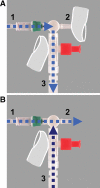Rescue ventilation through a small-bore transtracheal cannula in severe hypoxic pigs using expiratory ventilation assistance
- PMID: 25565319
- PMCID: PMC4358705
- DOI: 10.1213/ANE.0000000000000584
Rescue ventilation through a small-bore transtracheal cannula in severe hypoxic pigs using expiratory ventilation assistance
Abstract
Background: Suction-generated expiratory ventilation assistance (EVA) has been proposed as a way to facilitate bidirectional ventilation through a small-bore transtracheal cannula (TC). In this study, we investigated the efficiency of ventilation with EVA for restoring oxygenation and ventilation in a pig model of acute hypoxia.
Methods: Six pigs (61-76 kg) were anesthetized and ventilated (intermittent positive pressure ventilation) via a cuffed endotracheal tube (ETT). Monitoring lines were placed, and a 75-mm long, 2-mm inner diameter TC was inserted. After the baseline recordings, the ventilator was disconnected. After 2 minutes of apnea, reoxygenation with EVA was initiated through the TC and continued for 15 minutes with the ETT occluded. In the second part of the study, the experiment was repeated with the ETT either partially obstructed or left open. Airway pressures and hemodynamic data were recorded, and arterial blood gases were measured. Descriptive statistical analysis was performed.
Results: With a completely or partially obstructed upper airway, ventilation with EVA restored oxygenation to baseline levels in all animals within 20 seconds. In a completely obstructed airway, PaCO2 remained stable for 15 minutes. At lesser degrees of airway obstruction, the time to reoxygenation was delayed. Efficacy probably was limited when the airway was completely unobstructed, with 2 of 6 animals having a PaO2 <85 mm Hg even after 15 minutes of ventilation with EVA and a mean PaCO2 increased up to 90 mm Hg.
Conclusions: In severe hypoxic pigs, ventilation with EVA restored oxygenation quickly in case of a completely or partially obstructed upper airway. Reoxygenation and ventilation were less efficient when the upper airway was completely unobstructed.
Conflict of interest statement
Conflicts of Interest: See Disclosures at the end of the article.
Figures


Similar articles
-
Transtracheal ventilation with a novel ejector-based device (Ventrain) in open, partly obstructed, or totally closed upper airways in pigs.Br J Anaesth. 2015 Aug;115(2):308-16. doi: 10.1093/bja/aev200. Epub 2015 Jun 25. Br J Anaesth. 2015. PMID: 26115955
-
Emergency ventilation with the Ventrain® through an airway exchange catheter in a porcine model of complete upper airway obstruction.Can J Anaesth. 2017 Jan;64(1):37-44. doi: 10.1007/s12630-016-0760-5. Epub 2016 Oct 28. Can J Anaesth. 2017. PMID: 27796837 Free PMC article.
-
Intratracheal pulmonary ventilation in a rabbit lung injury model: continuous airway pressure monitoring and gas exchange efficacy.Crit Care Med. 2000 Jul;28(7):2480-5. doi: 10.1097/00003246-200007000-00049. Crit Care Med. 2000. PMID: 10921582
-
Studies in transtracheal ventilation catheters.Laryngoscope. 1982 Nov;92(11):1259-64. doi: 10.1288/00005537-198211000-00007. Laryngoscope. 1982. PMID: 6755116 Review.
-
Ventilation through small-bore airways in children by implementing active expiration.Paediatr Anaesth. 2022 Feb;32(2):312-320. doi: 10.1111/pan.14379. Epub 2021 Dec 22. Paediatr Anaesth. 2022. PMID: 34902197 Free PMC article. Review.
Cited by
-
S1 guidelines on airway management : Guideline of the German Society of Anesthesiology and Intensive Care Medicine.Anaesthesist. 2015 Dec;64 Suppl 1:27-40. doi: 10.1007/s00101-015-0109-4. Anaesthesist. 2015. PMID: 26727936
-
Near total intrathoracic airway obstruction managed with a Tritube (R) and flow-controlled ventilation: a reply.Anaesth Rep. 2022 Mar 22;10(1):e12155. doi: 10.1002/anr3.12155. eCollection 2022 Jan-Jun. Anaesth Rep. 2022. PMID: 35360362 Free PMC article. No abstract available.
-
A prototype small-bore ventilation catheter with a cuff: cuff inflation optimizes ventilation with the Ventrain.Acta Anaesthesiol Scand. 2018 Mar;62(3):328-335. doi: 10.1111/aas.13030. Epub 2017 Nov 8. Acta Anaesthesiol Scand. 2018. PMID: 29119549 Free PMC article.
-
Ventilation through a straw.Anesth Pain Med (Seoul). 2022 Jul;17(3):249-255. doi: 10.17085/apm.22163. Epub 2022 Jul 7. Anesth Pain Med (Seoul). 2022. PMID: 35918856 Free PMC article. Review.
-
Automated expiratory ventilation assistance through a small endotracheal tube can improve venous return and cardiac output.Intensive Care Med Exp. 2019 Jan 9;7(1):6. doi: 10.1186/s40635-018-0217-y. Intensive Care Med Exp. 2019. PMID: 30627962 Free PMC article.
References
-
- Henderson JJ, Popat MT, Latto IP, Pearce AC. Difficult Airway Society guidelines for management of the unanticipated difficult intubation. Anaesthesia. 2004;59:675–94. - PubMed
-
- Caplan RA, Benumof JL, Berry FA, Blitt CD, Bode RH, Cheney FW, Connis RT, Guidry OF, Nickinovich DG, Ovassapian A. Practice guidelines for management of the difficult airway. An updated report by the American Society of Anesthesiologists Task Force on Management of the Difficult Airway. Anesthesiology. 2003;98:1269–77. - PubMed
-
- Hamaekers AE, Henderson JJ. Equipment and strategies for emergency tracheal access in the adult patient. Anaesthesia. 2011;66(Suppl 2):65–80. - PubMed
-
- Wong DT, Lai K, Chung FF, Ho RY. Cannot intubate-cannot ventilate and difficult intubation strategies: results of a Canadian national survey. Anesth Analg. 2005;100:1439–46. - PubMed
-
- Ezri T, Szmuk P, Warters RD, Katz J, Hagberg CA. Difficult airway management practice patterns among anesthesiologists practicing in the United States: have we made any progress? J Clin Anesth. 2003;15:418–22. - PubMed
Publication types
MeSH terms
Substances
LinkOut - more resources
Full Text Sources

